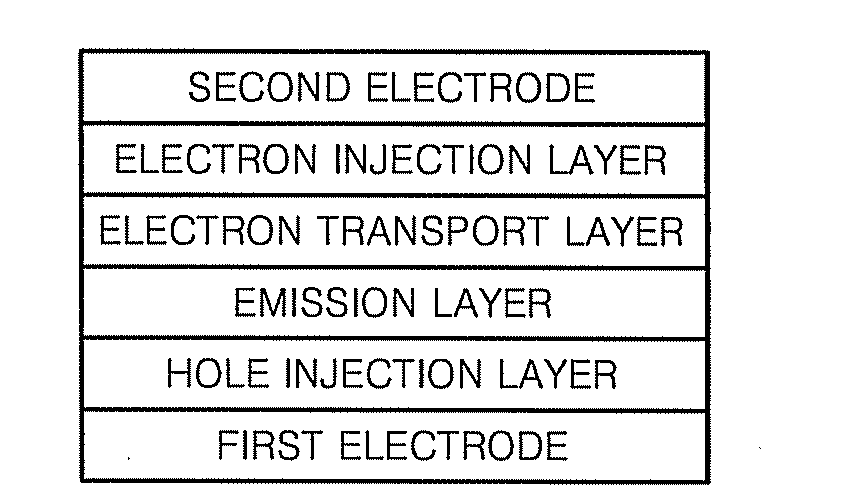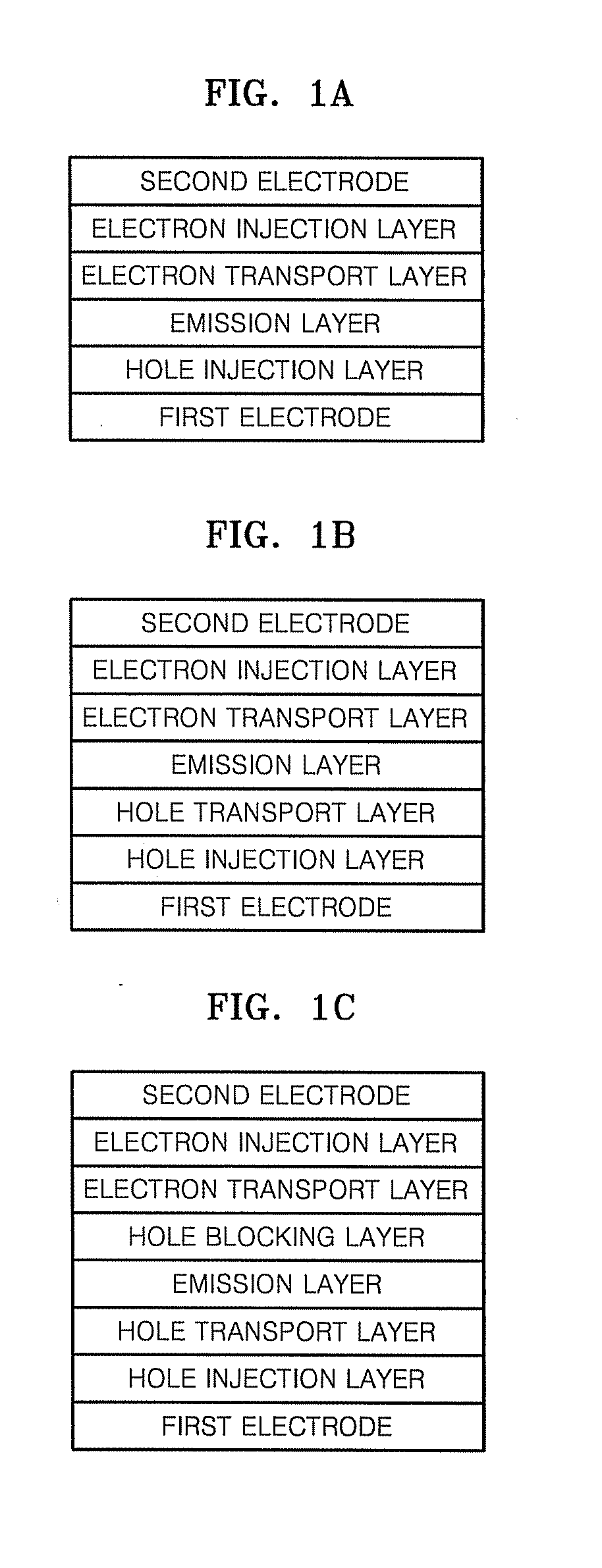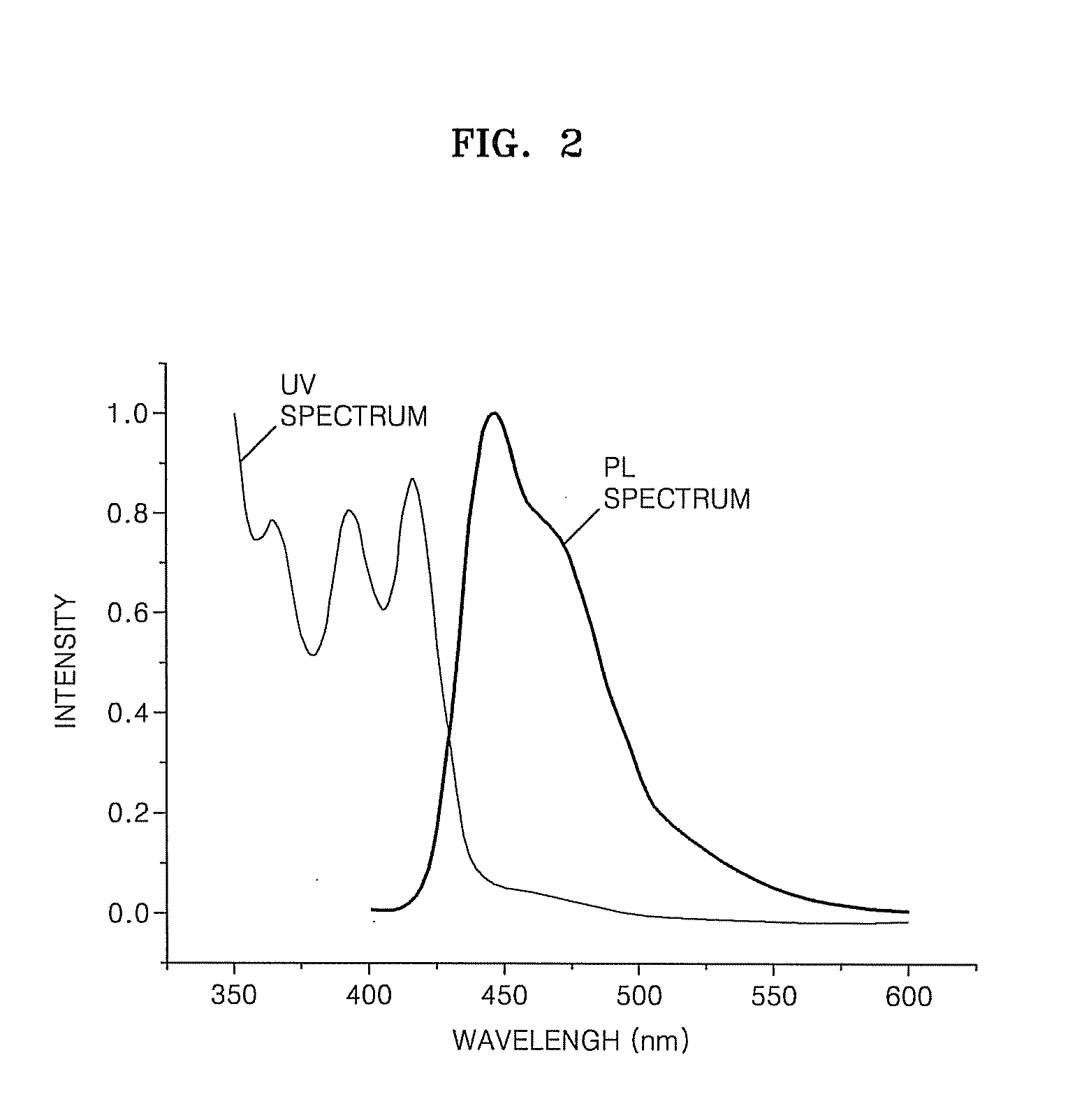Organic light emitting compound and organic light emitting device comprising the same, and method of manufacturing the organic light emitting device
a light emitting device and organic technology, applied in the manufacture of electric discharge tubes/lamps, discharge tubes luminescnet screens, anthracene dyes, etc., can solve the problems of poor thermal stability, color purity, thermal stability, and the like of materials that can be used in vacuum deposition, and achieve good solubility, high color purity, and high thermal stability
- Summary
- Abstract
- Description
- Claims
- Application Information
AI Technical Summary
Benefits of technology
Problems solved by technology
Method used
Image
Examples
synthesis example 1
[0066]Compound 4 represented by Formula 4 was synthesized through Reaction Schemes 1, 2 and 3:
Synthesis of Intermediate A
[0067]8.4 g of 2,5-dibromonitrobenzene (30 mmol), 10.8 g of 1-naphthaleneboronic acid (62.6 mmol), 520 mg of tetrakis triphenylphosphine palladium (Pd(PPh3)4) (0.45 mmol) and 63 ml of a 2M aqueous potassium carbonate solution (126 mmol) were dissolved in 100 ml of toluene, respectively, and then the mixtures were added to a 500 ml round bottom flask. Then, the mixture was refluxed for 24 hours. After the reaction was terminated, the solvent was removed by evaporation. Then, the residue washed with 500 ml of ethylacetate and 500 ml of water. Thereafter, the organic layer was collected and was dried with anhydrous magnesium sulfate. Subsequently, the dried organic layer was purified with silica chromatography to obtain 9.5 g of a compound represented by Intermediate A (yield 84%).
Synthesis of Intermediate B
[0068]8.0 g of Intermediate A (21.3 mmol) and 14 g of triphe...
synthesis example 2
[0071]Compound 8 represented by Formula 8 was synthesized through Reaction Scheme 4:
Synthesis of Compound 8
[0072]1.1 g of Intermediate B (3.2 mmol), 405 mg of copper (6.4 mmol), 1.8 g of potassium carbonate (12.8 mmol), 250 mg of 18-crown-6 (1 mmol), 970 mg of 9-(4-bromobiphenyl-4-yl)-10-phenylanthracene (2.2 mmol) were dissolved in 10 ml of nitrobenzene, and the mixture was added to a 500 ml round bottom flask and then refluxed for 24 hours. After the reaction was terminated, the solvent was removed by evaporation. Then, the residue washed with 100 ml of ethylacetate and 100 ml of water. Thereafter, the organic layer was collected and was dried with anhydrous magnesium sulfate. Subsequently, the dried organic layer was purified with silica chromatography to obtain 674 mg of a compound represented by Compound 8 (yield 41%).
[0073]1H-NMR (CDCl3, 300 MHz, ppm): 8.9-7.3 (m, 37H).
synthesis example 3
[0074]Compound 17 represented by Formula 17 was synthesized through Reaction Scheme 5 below:
Synthesis of Compound 17
[0075]427 mg of 7H-dibenzo[c,g]carbazole (1.6 mmol), 202 mg of copper (3.2 mmol), 879 mg of potassium carbonate (6.4 mmol), 126 mg of 18-crown-6 (0.48 mmol), 1.0 g of 4-bromo-(7,12-diphenyl)benzo[k] fluoranthene (2.1 mmol) were dissolved in 5 ml of nitrobenzene, and the mixture was added to a 500 ml round bottom flask and then refluxed for 24 hours. After the reaction was terminated, the solvent was removed by evaporation. Then, the residue washed with 50 ml of ethylacetate and 50 ml of water. Thereafter, the organic layer was collected and was dried with anhydrous magnesium sulfate. Subsequently, the dried organic layer was purified with silica chromatography to obtain 268 mg of a compound represented by Compound 17 (yield 25%).
[0076]1H-NMR (CDCl3, 300 MHz, ppm): 8.9-6.5 (m, 31H).
PUM
 Login to View More
Login to View More Abstract
Description
Claims
Application Information
 Login to View More
Login to View More - R&D
- Intellectual Property
- Life Sciences
- Materials
- Tech Scout
- Unparalleled Data Quality
- Higher Quality Content
- 60% Fewer Hallucinations
Browse by: Latest US Patents, China's latest patents, Technical Efficacy Thesaurus, Application Domain, Technology Topic, Popular Technical Reports.
© 2025 PatSnap. All rights reserved.Legal|Privacy policy|Modern Slavery Act Transparency Statement|Sitemap|About US| Contact US: help@patsnap.com



